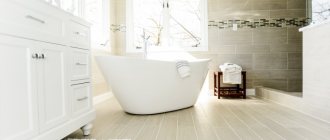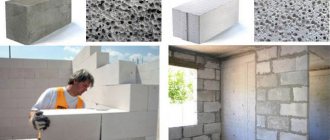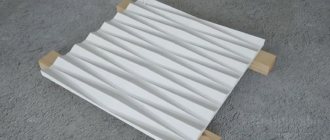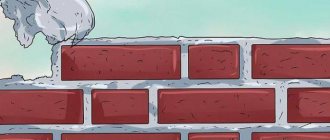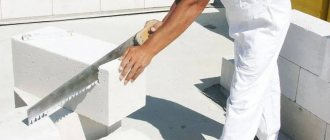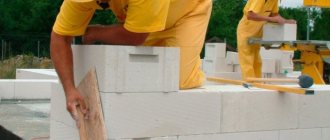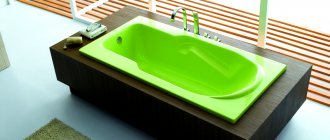Beton-House.com
Website about concrete: construction, characteristics, design. We combine the experience of professionals and private craftsmen in one place
Foam concrete, expanded clay concrete
The topic of comparing materials is gaining more and more popularity every year. This is due to the appearance on the market of an increasing number of new products that constitute worthy competition and the improvement by manufacturers of established technologies that attract more conservative consumers.
In this article we will consider the features and properties of wall materials. Expanded clay concrete or foam concrete: which is better? Let's analyze the characteristics and try to make the most correct choice.
- Overview of basic properties
- Features of foam concrete manufacturing
What is foam concrete
Now it’s time to figure out what foam concrete is and what characteristics it has. Let's start with the main qualities and properties that are of particular interest to developers.
Overview of basic properties
Let's use the table. Characteristics of foam concrete:
| Indicator name | Its meaning |
| Thermal conductivity | From 0.09 |
| Frost resistance | 15-100 cycles |
| Density | 300-1200 |
| Strength | From B 1.5 |
| Environmental friendliness | 2 |
| Fire resistance | Does not burn |
| Recommended minimum wall thickness | From 0.5 m |
| Water absorption | 10-16% |
Note! The thermal conductivity indicator is especially enviable for the material’s competitors. However, it is worth considering that it is typical for products in a dry state. With operating humidity, the numerical value increases. The maximum value can reach 0.4.
As in the case of expanded clay concrete, the ability to retain heat directly depends on the density of the products:
- Frost resistance is quite high, but foam concrete is still inferior to some materials.
- The density of the products makes it possible to erect buildings up to 12 meters in height.
- Water absorption is not so high. The ability to absorb moisture is somewhat reduced due to the special closed pore structure of foam concrete.
Now it’s worth paying a little attention to the composition of the material. Foam concrete is made from a mixture of cement, sand, water, foaming agent and specialized additives. The foaming agent provokes swelling of the solution, due to which the foam concrete has a cellular structure, which gives the material lightness and excellent thermal insulation qualities.
Important! Accordingly, the more pores, the lower the density and thermal conductivity.
Foam concrete structure
Types of material and products made from it
GOST has established more than one classification of foam concrete. Let's take a closer look at them.
Depending on the density, like expanded clay concrete, foam concrete can be of several types:
- Thermal insulation;
- Structural and thermal insulation;
- Structural.
Using the table, let us consider the main differences between the above types and the scope of application of the products.
The relationship between thermal conductivity and density of foam concrete, scope of application of products:
| Type of foam concrete | Average density indicator | Coefficient of thermal conductivity | Main Applications |
| Thermal insulation | 300-400 | 0,09-0,11 | It is used as a material for insulation, but cannot withstand loads due to the low density and strength of the material. |
| Structural and thermal insulation | 500-900 | 0,12-0,25 | It is used in the construction of walls and partitions, and is used in the construction of buildings several floors high. Most popular among private developers. |
| Structural | 1000-1200 | 0,26-0,34 | The most durable type of foam concrete. Able to withstand significant loads. It is used for the construction of load-bearing walls and structures. Needs additional insulation due to the high thermal conductivity coefficient. |
It is worth noting that there are also foam concrete blocks of higher density than structural ones; they are called structurally porous. Their density reaches 1500 kg/m3.
They are not widely used and are produced in small batches for individual orders. They are not regulated by GOST.
Depending on the hardening method, foam concrete can be:
- Autoclaved. Such products are processed in special chambers - autoclaves. It is there that the blocks reach technical maturity by exposing them to high temperature and pressure.
- Non-autoclave. Such blocks harden under natural conditions. They reach brand strength only after 28 days.
They are distinguished by lower strength, frost resistance, and greater fragility. Their color is more gray.
Depending on the type of binder, foam concrete can be made:
- On cement;
- On lime;
- On slag;
- On a mixed binder;
- On ash binder.
The content of the main component can reach over 50%. The minimum threshold is 15%.
According to the type of silica component, products can be:
- On sand (most often quartz);
- On the ashes;
- On other secondary industrial products.
It is also worth noting that foam concrete products may differ from each other in geometric deviations. Let's look at them using a table.
Categories of accuracy of foam concrete blocks:
| Name of deviation | First category blocks | Blocks of the second category | Blocks of the third category |
| To size | No more than 1.5 mm | No more than 2 mm | No more than 5 mm |
| Diagonally | No more than 2 mm | No more than 4 mm | No more than 7 mm |
| Chips in corners | No more than 3 mm | No more than 5 mm | No more than 8 mm |
| Chips on the ribs | No more than 3 mm | No more than 5 mm | No more than 10 mm |
Note! Exceeding the above deviations is permissible for no more than 5% of products in a batch for each indicator. No more than 2 broken corners are allowed in one block.
Foam concrete blocks can have a lined side (1 or 2). Such products do not require subsequent external finishing. In addition to blocks, foam concrete is also used in liquid form.
Basically, it is used:
- When insulating the roof;
- When pouring screeds and foundations under a heated floor;
- When creating monolithic structures
Advantages and disadvantages
Foam concrete has many positive qualities:
- Environmental friendliness and fire resistance.
- The low weight of the products will reduce the load on the building foundation.
- The large dimensions of the block contribute to a significant increase in construction speed.
- The material is easy to process, easy to saw and sand. This does not require the use of highly specialized tools.
- Due to the closed pore structure, water absorption is not so high and is about 10%.
- The cost of production is one of the lowest among cellular concrete.
- The frost resistance, density and thermal conductivity indicators are good enough for the construction of a practical and durable building.
- The vapor permeability of the material can create the most favorable microclimate. Foam concrete is able to absorb excess moisture and release it when the air is dry.
- The variety of sizes and large selection of manufacturers is also a significant plus.
- The ability to soundproof will protect those present in the building from extraneous sounds.
- Ease of manufacture and the possibility of self-release.
Advantages of foam concrete
Weaknesses also exist.
The main disadvantages are:
- Poor adhesion to finishing materials, which necessitates additional costs for primer, reinforcing mesh and expensive plaster mixtures.
- Poor fixation of fasteners and the need to use special hardware. To secure heavy objects, it is necessary to plan fastening points at the design stage and strengthen them.
- The presence of handicraft industries is another disadvantage. You can protect yourself from purchasing low-quality products only by checking the availability of appropriate documentation from the supplier in the form of certificates of conformity.
- Fragility of products. Foam concrete crumbles easily and breaks under mechanical stress.
- Blocks are prone to shrinkage, which often leads to cracks in the masonry.
Production technology and components
The composition of the substances and the methods of their manufacture are, at first glance, very similar to each other. In fact, when comparing which is better - expanded clay block or foam block, their differences become clear.
Components
The main ingredients of both substances are Portland cement (M400 and above), water and sand.
Foam blocks
A foaming agent is added to foam concrete to form heat- and sound-insulating voids.
Foam concrete components by brand
Foam block structure
Thus, the composition of the finished foam block is a homogeneous mass, which is like a cellular lattice made of a hardened cement-sand mixture. Small pores are evenly distributed throughout the entire volume of the block.
Expanded clay block
To make expanded clay concrete, expanded clay (gravel or crushed stone), consisting of foamed, baked clay, is added to the mixture of cement and sand.
Composition of expanded clay concrete for blocks
The structure of the substance of an expanded clay block is the same lattice of sand and cement, similar to a foam block. The “cells” of the lattice are filled not with air, but with frozen layers of clay. The main noise and heat insulation is achieved through voids in the structure, and not in the substance of the block.
Forms of expanded clay concrete blocks
Important! Comparison: which is better - foam block or expanded clay concrete, in this case is not fair. It is impossible to apply indicators of the solid mass of expanded clay concrete to a frame product.
- At the same time, it is impossible to calculate the characteristics of an expanded clay block based on its external dimensions and weight. Heat leakage will be higher in the case jumper areas.
- For a foam block, since it is homogeneous throughout its entire volume, it is possible to use foam concrete indicators.
- The characteristics of an expanded clay concrete block depend on the ratio of the volume of its frame to structural voids and the brand of expanded clay concrete used to make the body.
Summary of comparison of block components
When choosing a foam block or expanded clay block, which is better in composition, the following factors are taken into account.
- The voids in the substance of the expanded clay block are reinforced with clay, which means they have a higher density and moisture resistance. Cold bridges may occur across the jumpers.
- When constructing walls, expanded clay blocks will require additional insulation and/or an increase in wall thickness.
Insulation of expanded clay concrete walls.
- The cells of foam blocks are filled with air, therefore, they retain heat better, but they absorb liquid more easily and have less strength.
- For foam blocks, waterproofing and protection from mechanical damage are more important.
It’s easy to create such protection and insulation with your own hands; no instructions are needed.
The density and strength of the blocks are selected depending on the load.
Production
The main difference in technology, important in choosing which is better, a foam block or expanded clay block, is the change in the density of the initial mixture during their manufacture.
Expanded clay concrete block
It is made as follows:
- The semi-dry mixture (the composition depends on the required strength grade) is poured into molds;
- Placed in a vibropress;
- Products are formed under pressure of several tens of atmospheres, after which the blanks are dried for 1-2 days.
Production of expanded clay concrete blocks
The manufacturing technology, as well as the composition, of expanded clay concrete blocks is aimed at increasing the density and strength of the product substance. The more voids, the better the thermal insulation, but the worse the strength.
Foam block
In this case, the following actions are performed:
- The initial dough is kneaded in a mixer with high speed blades;
- Mechanically, the solution is whipped into foam, after which it is poured into molds;
- The maturation of foam concrete should last at least 28 days.
Industrial equipment for the production of foam concrete
Foam blocks of greater strength contain an increased proportion of cement and sand. Accordingly, foaming becomes more difficult, density and weight increase, and thermal insulation qualities decrease.
Summary of technology comparison
Again, as with the components, the choice is: “foam blocks or expanded clay blocks, which is better?” is a choice between strength and thermal conductivity. However, the desired balance can be found in both cases.
Important! During the operation of the building, it may be necessary to hang a heavy object on the wall. Expanded clay concrete block will hold the load better.
Simple technology and the low price of minimal equipment give rise to a large number of low-quality products. When buying foam blocks or expanded clay blocks, you should not chase the lowest cost.
In the photo: equipment for the production of expanded clay and foam blocks with your own hands
Comparison of materials
Now let's compare the materials with each other and find out: expanded clay concrete blocks or foam blocks - which is better?
Let's use the table. What is better expanded clay concrete or foam concrete:
| Indicator name | Comparison and analysis of the indicator |
| Frost resistance | In this indicator, expanded clay concrete definitely wins. It's typical for him. As already mentioned, up to 200 freeze-thaw cycles. |
| Density | It is also superior in density to expanded clay concrete. The numerical value can reach 2000 kg/m3. |
| Thermal conductivity | But foam concrete wins in thermal conductivity, which is directly related to the lower density of the material. |
| Shrinkage | Shrinkage is not typical for expanded clay concrete; foam concrete, in turn, cannot boast of this. |
| Complexity of processing and speed of construction | Expanded clay concrete is difficult to process. As for the speed of construction, it seems that foam concrete is somewhat ahead of its competitor. However, based on the size, the dimensions of both products are quite large. |
| Product price | Foam concrete is cheaper, about 10-15% depending on the region and manufacturer. |
| Environmental friendliness | Both materials do not contain toxic substances and are absolutely safe for others. |
| Prevalence, scope of application | In general, both materials are common. However, expanded clay concrete, in this case, is still worth highlighting. It is used in the construction of foundations and plinths, which is not typical for foam concrete. Based on this, its scope of application is wider. |
| Water absorption | Both one and the second material are capable of absorbing moisture. |
| Variability of finishes | Walls made of expanded clay concrete and foam concrete can be finished using almost any material. The main thing is to observe technical validity. |
| Additional expenses | Additional costs are expected in greater quantities during the construction of foam concrete. It has significantly worse adhesion than expanded clay concrete. |
| Difficulty of installation | The installation technology is extremely similar, so we can say that in this case there is no winner. |
| Complexity of the production process | Both expanded clay concrete and foam concrete are not difficult to manufacture. Both materials can be produced independently. In this case, enormous costs will not be required. |
As you can see, each material is good in its own way. And if you had to compare expanded clay concrete and foam concrete, then the choice is probably not easy to make. To make the right decision, you should decide which qualities are most important to you - only in this case, answer the question “which is better?” it will be much easier.
Technical characteristics of foam concrete
The production technology of this building material is so simple that it can be produced directly on the construction site, since it only takes a few hours to completely harden. Equipment for the production of foam concrete can be purchased or simply rented. The composition of foam concrete includes cement (not lower than grade M400), filler (ordinary sand is often used), water, additives (plasticizer, fiber, hardening accelerators), as well as special foam (foaming agent). All these components are mixed and poured into prepared forms, where they remain until they completely harden. The cost of producing foam concrete, as well as expanded clay concrete, is quite low.
The main characteristic of foam concrete is its density. The denser the material, the stronger the block made from it will be. Foam concrete combines the properties of wood and stone, namely: reliability and strength, which are characteristic of stone, as well as lightness and the possibility of simple processing, which is so characteristic of wood. At the same time, it is used in construction not only as a material for structural construction, but also as a reliable insulation material. Buildings made of foam concrete are considered highly comfortable, since this material is able to “breathe”, but at the same time it does not allow street noise to pass through at all. In addition, it is fireproof, durable and at the same time has excellent thermal insulation properties. And if the choice is a foam block or expanded clay block based on such a parameter as weight, then we note that the first is almost 2.5 times lighter than the second. A standard foam concrete block has dimensions: 600 x 300 x 200.
Production cycle overview
Since we have already compared the qualities and properties, it is worth briefly considering the manufacturing features of both materials and analyzing the level of complexity and amount of labor costs. Perhaps, when choosing, this will become a powerful argument.
Features of foam concrete manufacturing
Foam concrete can be produced in several ways:
- Classic technology;
- Barotechnology;
- Dry mineralization method.
Classic technology is the most common.
The stages of work are as follows:
- A foaming agent is introduced into the cement mortar;
- The prepared solution is poured into molds;
- Semi-finished products are subjected to stripping (when manufactured in a single layer, they are pre-cut into standard sizes);
- Processed in an autoclave or kept for 28 days using a non-autoclave production method.
The dry mineralization method differs in that the ingredients are mixed dry.
The barotechnology method involves supplying foam through high pressure, without the use of a foam generator. The method is often used during continuous production on a construction site.
The equipment can be used in several types:
- Mini line. Differs in the minimum daily volume of production. Suitable for home production and small businesses.
- A stationary line is more expensive; you can choose the equipment yourself. Productivity is higher, labor costs are lower.
- The conveyor line is the most automated. It is used in large-scale production, the daily production volume can reach 200 m3. Features minimal human intervention.
Products made using this line are of higher quality and geometrically smooth.
Production of expanded clay concrete: review of equipment and step-by-step analysis of the work process
To produce expanded clay concrete, you will also need certain equipment.
The lines can be either fully automated or partially manual (mini-line). A standard set of machines, tools and raw materials suitable for home use includes:
- Concrete mixer;
- Vibropress;
- Cement, sand, water, expanded clay and plasticizer (liquid soap can be used);
- Container in the form of a bucket or trough.
The sequence of work looks like this:
- The solution is mixed. Water is poured in first, followed by all the ingredients;
- The finished solution should have a consistency similar to sour cream;
- The next step is molding. To do this, you will need vibrating compaction equipment, which, using vibration, compacts the solution.
- Excess mixture is removed with a special knife;
- The metal plate with the products is dried for several days, after which they are unmolded;
- Like foam concrete, expanded clay concrete products need to gain strength within 28 days.
- It is also worth mentioning the presence on the construction industry market of a combined material called expanded clay foam concrete.
- It is manufactured using modern technology. The essence of the method is as follows: components in the form of water, expanded clay, cement and foaming agent are sequentially loaded into the mixer. The latter is supplied in the form of a solution by spray.
- This innovation relates to the production technology of panels for walls made of expanded clay foam concrete.
- The main goal of such production is to obtain a finely porous solution structure with closed pores, which undoubtedly led to a decrease in thermal conductivity and density, due to an increase in the amount of air in the solution and a uniform distribution of cells.
Recommendations for the production of expanded clay foam concrete products
Briefly about the profitability of production of both materials, possible prospects
If we talk about profitability, then producing expanded clay concrete and foam concrete is economically profitable.
The result largely depends on a number of factors, which include:
- Features of the region, including purchasing power;
- Investments in business, type of equipment and productivity;
- Speed of sales of finished products;
- Business expenses, number of employees and much more.
In any case, for proper planning, it is recommended to first draw up a business plan that will take into account all possible income and expenses and will be able to predict the approximate outcome.
Even if we assume that the cost of one m3 of expanded clay concrete is about 2,200 rubles, and it can be sold for 3,200, then, provided that 30 m3 are produced per day (this is a small volume) and sold, you can earn 900,000 in a month. This, you see, good income.
A set of budget equipment will cost approximately 800,000. It is easy to calculate that in an optimistic scenario, it can pay for itself in 1-2 months.
What is expanded clay block
Expanded clay block is a building stone . It is made from expanded clay concrete - a mixture of cement, sand, water and expanded clay. Sometimes air-entraining additives are included in the composition to increase frost resistance.
Tip: if you store expanded clay blocks outdoors, wrap them with plastic wrap on all sides. After all, expanded clay is a porous material that easily absorbs water. If it rains, in a couple of days the blocks will become too heavy to lift - each will become 2-3 times heavier.
Composition of expanded clay concrete:
- Expanded clay is burnt pieces (gravel) of clay. Light and porous, but hard. In expanded clay blocks, gravel of a fraction of 5-10 mm .
- Cement grade - M-300, or higher.
- Pure water (no impurities)
- Air-entraining additives - saponified wood resin (STR), or others.
- Construction sand.
Environmentally friendly. This is a safe material - just a frozen mixture of cement, sand and expanded clay.
Thermal insulation - 0.4-0.8. Better than wood and brick, but worse than foam concrete and aerated concrete.
Expanded clay blocks are divided according to 4 parameters:
By purpose - into three types:
- Thermal insulation - load-bearing walls cannot be installed.
- Structural and thermal insulation - you can lay load-bearing walls up to 2-3 floors.
- Structural - you can lay load-bearing walls up to 12 floors.
According to the parameters - for walls and partitions.
- Wall - capable of withstanding high compressive and breaking loads, so load-bearing walls of a building are laid from them.
- Partition walls - they are used to lay partitions, that is, those walls on which the main weight of the house does not rest.
According to the form . There are two types of expanded clay blocks:
- Solid - solid, without internal or external voids.
- Hollow - with internal and through voids. Voids are created during the pressing stage. Such a block is lighter and “breathes” better - it allows air to pass through, which improves the microclimate in the house.
For ordinary and facing :
- The dry, inner part of the wall is laid from the ordinary ones. Ordinary blocks do not have a protective surface treatment - therefore they are afraid of frost, snow and rain. Cheaper than facial ones.
- Facades are used to decorate the facades of buildings. Protected from weather conditions, but more expensive.
Wall masonry using both materials
The masonry technology for constructing walls from both materials is extremely similar, so we will consider the general principles and rules.
The stages of work are as follows:
- Laying blocks always starts from the corners: the blocks are installed, and a thread is pulled between them, serving as a guide.
- It is recommended to lay the first row on mortar for better adhesion to the base.
- Experts advise laying the second and subsequent rows using specialized adhesives. The thickness of the seam should be small in order to reduce cold bridges.
- If there is a gap in the row, the block must be cut to the required size.
- Control and adjustment of the evenness of the masonry is carried out using a building level and a rubber hammer. This should be done as often as possible, as the solution sets quickly. and it is not possible to disassemble the finished masonry.
- Each subsequent row is laid with a seam offset of 25-30%.
- The first and every fourth row produce reinforcement.
- The final stage is the installation of an armored belt.
Some tips when carrying out masonry work:
- When preparing the solution yourself, keep in mind that it should not be excessively liquid;
- The grade of cement must be at least M400;
- There should be no cracks or gaps;
- It is definitely worth pre-waterproofing the foundation.
- When ligating blocks, you must use the rules prescribed in the technical documentation.
- It is not recommended to mix a large amount of solution at once. It sets quickly, you need to have time to work it out.
The video in this article will tell you more about the stages of laying expanded clay concrete and foam concrete blocks.
Laying expanded clay concrete blocks
Using the Advantages and Disadvantages of Blocks
The most rational thing is not to compare which is better, expanded clay blocks or foam blocks, but to use them together.
Expanded clay concrete blocks
Expanded clay blocks are best used in places subject to greater load and moisture. For example, at the bottom of the wall and in the corners of the structure.
Expanded clay blocks are the load-bearing part, and foam blocks are the insulation
With this solution, good waterproofing of the facade will be required, but heat loss will be reduced.
Foam block
Revealed during the comparison: “foam block and expanded clay concrete, which is better?” The advantages of foam block in terms of weight and thermal conductivity are more rational to use for the upper and partition parts of the structure.
In this case, the 1st floor is monolithic, and the second floor is made of foam blocks
Advice! The flat surface of the foam blocks facing the inside of the building will reduce the cost of plastering the rooms.
The video in this article will help you learn more about the materials described.

